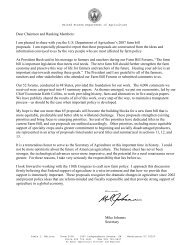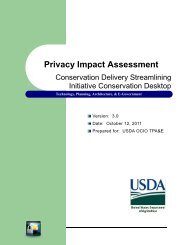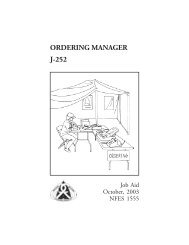ICS 200 â Lesson 2: ICS Features and Principles - US Department ...
ICS 200 â Lesson 2: ICS Features and Principles - US Department ...
ICS 200 â Lesson 2: ICS Features and Principles - US Department ...
You also want an ePaper? Increase the reach of your titles
YUMPU automatically turns print PDFs into web optimized ePapers that Google loves.
<strong>ICS</strong> <strong>200</strong> – <strong>Lesson</strong> 2: <strong>ICS</strong> <strong>Features</strong> <strong>and</strong> <strong>Principles</strong>Roaring River Flood: Management Functions ActivitySituation: At this point in the incident, the Incident Comm<strong>and</strong>er has a limited number of staffmembers who can be assigned to management functions.What is the Incident Comm<strong>and</strong>er’s best course of action?The Incident Comm<strong>and</strong>er’s best course of action is to assume responsibility for all functionsthat cannot be staffed <strong>and</strong> delegated.Every incident or event requires that certain management functions be performed. Even if anincident is very small, <strong>and</strong> only one or two people are involved, these activities will still alwaysapply to some degree. Remember:• Comm<strong>and</strong> should never be delegated. In addition, comm<strong>and</strong> should always be exercised fromthe Incident Comm<strong>and</strong> Post.• Delaying planning is not a good option. Without an effective planning function, incidentmanagement will become increasingly chaotic <strong>and</strong> ineffective, <strong>and</strong> will most likely fail.• Rotating assignments is not viable because it would result in an unclear chain of comm<strong>and</strong><strong>and</strong> a lack of management continuity.Organizational FlexibilityThe <strong>ICS</strong> organization reflects the principle of management by objectives. Every incident hasdifferent requirements. The organizational structure should reflect only what is required to meet<strong>and</strong> support planned incident objectives.The size <strong>and</strong> structure of the current organization is determined by the incident objectives. Eachactivated element must have a person in charge of it. As objectives are achieved, elements thatare no longer needed should be reassigned, or demobilized.Roaring River Flood: Implementing Organizational FlexibilityThis incident is going to need a lot of planning <strong>and</strong> logistical support. To support our initialincident objectives we need to assign staff to verify the initial assessments.Incident Comm<strong>and</strong>er“This incident is going to need a lot of planning <strong>and</strong> logistical support. To support our initialincident objectives, we need to assign staff to verify the initial assessments.Considering the large flood impact area, there’s likely to be a lot of competition for resources.And after we secure needed resources, it will take some time for them to mobilize. And ofcourse, the organization will exp<strong>and</strong> to reflect the tactics related to implementing the objectives.What’s important is that we exp<strong>and</strong> the structure based on operational needs <strong>and</strong> without chaos.I plan to activate the Section Chiefs first. Each Chief in turn will manage the assigned function<strong>and</strong> determine appropriate staffing.”6
















